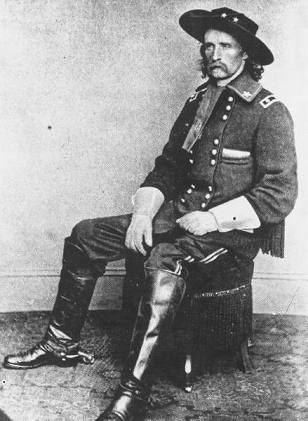|
It’s
not hard to figure that Gen. George Armstrong Custer’s time in Texas
was controversial and paradoxical. His entire military career was
that way, starting when he graduated last in his class at West Point
in 1861 until the bitter end at Little Big Horn in 1875. Custer stirred
controversy and debate in his own time, and historians have continued
the debate to the present day. Brilliant or buffoon? Martyr or imbecile?
The debate continues.
Distinguished by shoulder-length curly blonde hair, a red tie and
sailor’s blouse, he was something of a dandy and something of his
own creation. He became to the world the dashing and daring soldier
that he imagined himself to be when he was a boy growing up in Ohio.
That boyhood dream became a reality in the Civil War when Custer distinguished
himself as a daring – some said reckless – commander who led Union
troops successfully at Gettysburg and other major battles and pursued
Confederate General Robert E. Lee to Appomattox. |
 |
Gen. George Armstrong
Custer
Wikimedia Commons |
Lee’s surrender
at Appomattox ended the Civil War for most people, though Texas
was among the states that didn’t officially surrender until a month
later. The entire South, including Texas,
was ravaged by anarchy in the immediate aftermath of the war. The
U.S. also feared that the Confederates would regroup in Mexico under
emperor French emperor Maximillian.
Gen
Phil Sheridan sent Custer and a thousand or so volunteer troops to
Texas in 1866 to help restore and maintain
order, but Custer had his hands full maintaining order among his own
troops. The conflict arose over Custer’s refusal to let the soldiers
pillage and plunder the countryside to their heart’s content.
When they arrived at Hempstead
in August of 1866, Custer issued orders that made it clear that “foraging”
the land and its bounty would not be tolerated. Anyone found guilty
of disobeying those orders would have his head shaved and receive
25 lashes of the whip. Once bloody and shorn soldiers started showing
up in camp, the foraging stopped.
This measure, though successful, was also controversial. Custer was
accused of violating the Reconstruction Laws that “no cruel or unjust
punishment” be inflicted on “disturbers of the public peace and criminals.”
Custer argued that the punishment was neither cruel nor unjust and,
besides, it worked, which allowed him to follow his own orders in
regard to protecting Texas planters and
farmers from the troops.
The New York Times seemed to agree. “Gen’l Custer, knowing that the
trial for desertion was a farce, tried every humane way to save his
army from going to pieces, but failed,” a correspondent wrote. “He
then tried a new way, and flogged several men and shaved their heads.
This had the desired effect, but brought down the friends of these
soldiers upon him, who charge him with being disloyal, inhuman, and
everything that is bad. Now, I leave it to everyone if Custer didn’t
do right.”
Custer’s peculiar disciplinary measures alienated many of his troops
(and some authorities in Washington) but not the people who Texas,
who would generally recall Custer fondly, mainly because he had protected
them from those who would have preyed upon the land and the people
who lived on it and from it.
The ban on foraging was particularly galling to the soldiers as they
marched into Texas with a lot or orders
and drills but few rations. Custer assured them that rations would
be available at Hempstead,
but that turned out to be not true. The troops spent two unhappy months
there, and then marched to Austin.
The Custers moved into the old Blind Asylum building on the outskirts
of town, now restored and a part of the University of Texas campus. |
| For
Custer’s wife, Libbie, who wrote about her experiences in Texas
in her book “Tenting on the Plains,” the stay in Austin
was an idyllic time, coming as it did between the Civil War and the
Indian Wars on the Plains. They spent a lot of time horseback riding
and at the race track. Custer liked a little place on Shoal Creek
so much that he had a makeshift jail built there. “Armstrong was having
the time of his life, even while performing the unpleasant and unrewarding
task of taming Texas,” one biographer
wrote. For her part, Libbie enjoyed the luxuries of a bathtub, furniture,
a fireplace and a social life. |
|
It was nice while
it lasted. He was mustered out of the volunteers in February of 1867,
and would eventually take command of the Seventh Cavalry, where he
would meet his fate and seal his name in the history books at Little
Big Horn. The Texas legislature passed
a resolution of condolence, noting that Custer had endeared himself
to the people of Texas during his brief
stay.
© Clay Coppedge
"Letters from Central Texas"
February 23, 2011 Column
|
|
|
